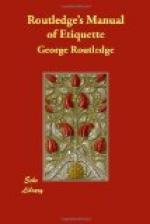* * * * *
VIII.—COULON’S DOUBLE QUADRILLE.
This quadrille contains the same figures as the common quadrille, but so arranged that they are danced by four instead of two couples. All quadrille music suits it; and it occupies just half the time of the old quadrille. It makes an agreeable variety in the movements of the dance, and is easily learnt. It requires four couples.
First Figure.—Pantalon.
First and second couples right and left, whilst side couples dance the chaine Anglaise outside them. All four couples set to partners and turn them. Four ladies form ladies’ chain, or hands across in the middle of the figure, giving first right hands, and then left, back to places. Half promenade, first and second couples do chaine Anglaise, while side couples do grand chaine round them. This leaves all in their right places, and ends figure.
Second Figure.—L’Ete
First lady, and lady on her right hand, perform the figure with their vis-a-vis gentlemen, as in common L’Ete; taking care, when they cross, to make a semicircle to the left. Second couple and second side couple repeat figure, as in common. L’Ete.
Third Figure.—La Poule.
Top lady and vis-a-vis gentleman, lady at her right, and her opposite gentleman, perform figure at the same time, setting to each other in two cross lines. Other couples follow as usual.
Fourth Figure.—La Pastorale.
The first and opposite couples dance the figure, not with each other, but with the couples to their right. The latter do the same with first and second couples.
Fifth Figure.—Finale.
Galopade all round. Top and opposite couples galopade forwards, and retreat. As they retreat side couples advance; and, as they retreat in their turn, first and second couples galopade to each others place. Side couples the same. First and second couples advance again; side couples the same as the others retreat; first and second back to places as side couples retreat. Side couples back to places. Double chaine des dames, and galopade all round. Then side couples repeat figure as usual, and galop all round in conclusion.
It is requisite to keep correct time and step in this quadrille, which would otherwise become much confused.
* * * * *
IX.—THE POLKA.
The origin of this once celebrated dance is difficult to ascertain. It is believed by some to be of great antiquity, and to have been brought into Germany from the East. Others affirm that its origin is of more recent date, and its birthplace considerably nearer home. An authority on these matters remarks; “In spite of what those professors say who proclaim themselves to have learnt the Polka in Germany, or as being indebted for it to a Hungarian nobleman, we are far from placing confidence in their assertions. In our opinion Paris is its birthplace, and its true author, undoubtedly, the now far-famed Monsieur Cellarius, for whom this offspring of his genius has gained a European celebrity.”




